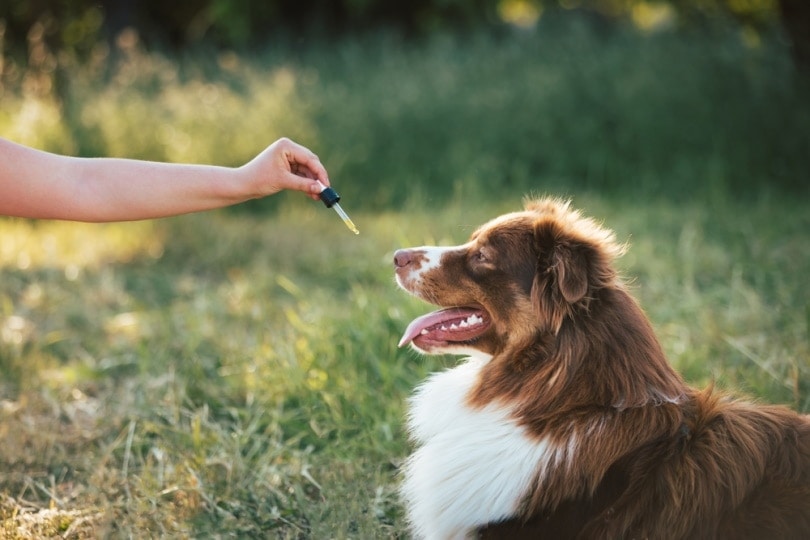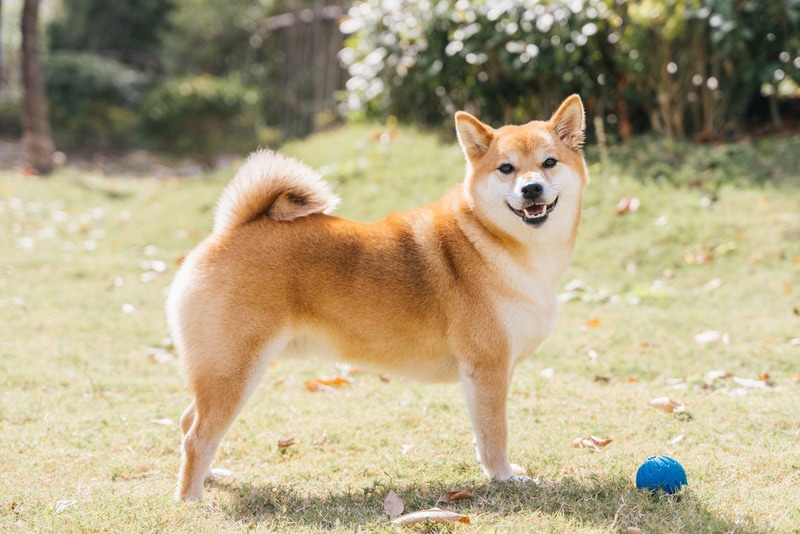15 Great Bernese Mountain Dog Grooming Tips (Canine Care and Wellness)
By Beth Crane
Updated on
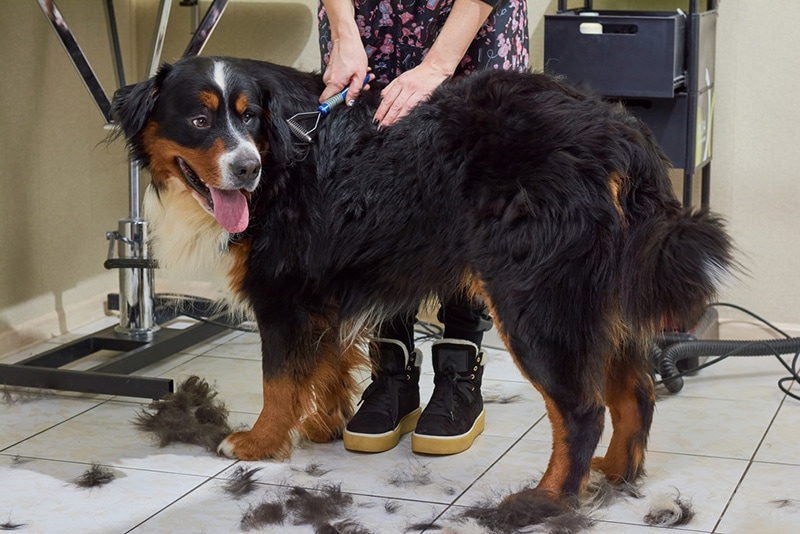
Bernese Mountain Dogs are beautiful dogs with thick, instantly recognizable coats. They’re a breed that’s built to work; they’re at home in the Swiss Alps mountains, where they’re used as farm dogs. The Bernese Mountain Dog is the only dog in the Sennenhund group (alpine herders) with long hair.
The Bernese has an even and calm temperament, so grooming this long, thick fur is usually enjoyable, but you can never have enough tips and tricks up your sleeve! We gathered 15 great tips to help you groom your Bernese Mountain Dog thoroughly, ensuring you both enjoy the experience.
Before You Begin: Gather Your Equipment
You should never leave your dog alone around sharp equipment like shears or in the bath. This is especially dangerous, so make sure you have all your equipment on hand before you start! It’s also best to allocate enough time to groom your Bernese, as they are large, thick-furred dogs that can take some time to groom. Lastly, ensure you have some treats to encourage your pup; not only will it keep them sweet while you’re grooming them, but it’ll make the experience pleasant for you both.
Equipment you’ll need to groom your Bernese Mountain Dog includes:
- Brushes that can handle a thick coat, like heavy-duty pin and bristle brushes, and a slicker
- A hand-held comb
- Blunt-ended shears
- Treats
The 15 Great Bernese Mountain Dog Grooming Tips
1. Make Grooming Fun From Start to Finish
Grooming doesn’t have to be a stressful experience for you and your dog. Get yourself and your dog comfy on the floor (tables are a bad idea for Bernese as they’re so large), and check your dog’s response to the process regularly as you groom. Talk to your dog during the process, as grooming sessions are a great opportunity to bond.
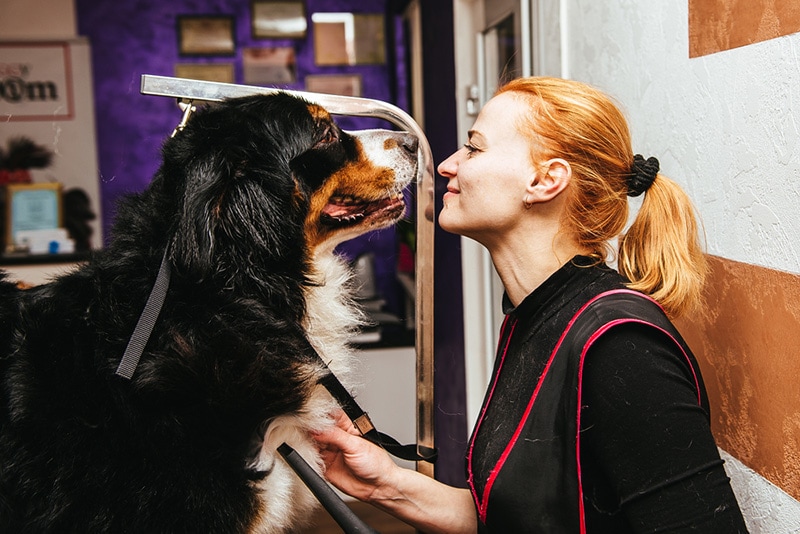
2. Begin by Loosening the Coat
When you begin grooming, separating your dog’s coat into sections is a good idea. Bernese Mountain Dogs have thick, double-layered coats; ensuring you reach the underlayer is key to preventing tangles from forming. Use a wide-toothed comb to identify any areas of tangling and gently tease them out. Working through the top layer first can help with visibility.
3. Section the Hair
Once the coat has been loosened, you can begin to work on combing it out in sections. Begin working at the underlayer first, holding the longer overcoat out of the way while you brush. Make sure to empty your brush regularly as you work, as there will be lots of shed hair. This method ensures the coat is thoroughly groomed, so while it does take time, it’s worth the effort.
4. Identify Any Areas of Large Knotting
Look for clumps of knots or tangles as you brush. Owners can gently tease out small tangles with their fingers while they work through the coat, but larger clusters will need to be thinned out first or might even need cutting out if they can’t be untangled. Brush through the untangled hair thoroughly but gently.
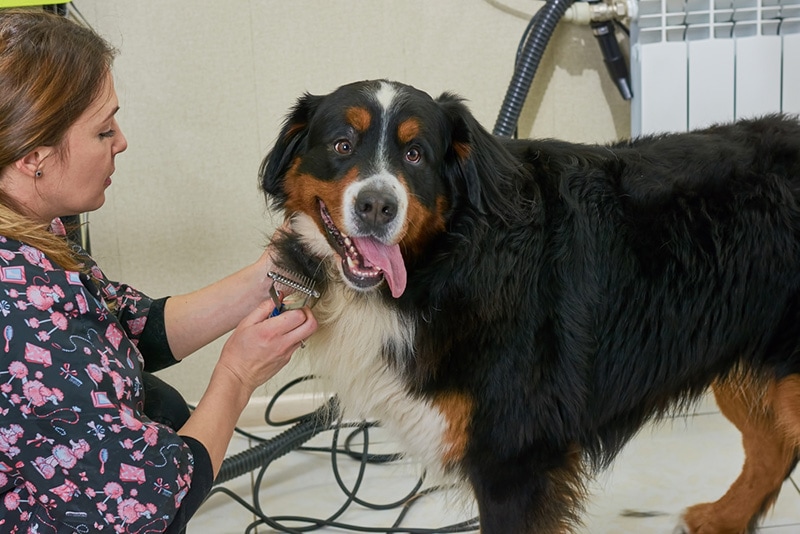
5. Don’t Forget the Undercarriage
Areas like the armpits, belly, and between the legs are covered in finer hair than on the rest of your Bernese Mountain Dog’s body. This fur is often longer and tufty, meaning it can get tangled easier. These areas are sensitive, but unfortunately, they often require more grooming. This is due to the fur movement in the area, increasing the chance of knots forming (particularly in the armpits). Make sure you’re careful when you comb this hair out, and stop if you come to a knot you’re uncomfortable removing.
6. Pay Attention to the Genital Area
Both male and female Bernese Mountain Dogs will have fur covering their genitals that needs to be addressed. Male dogs have tufts of hair at the end of their penis that can get tangled and dirty, so a groom (and a wash) is needed. Wash off any dirt with warm water and gently separate any clumps of fur or knots. Female Bernese might need a clean and gentle brush if they are in season and not neutered.
7. Dealing With Tufts
Being long-haired dogs, the Bernese has several areas that can grow longer, more tufty hair. This feathering can grow very long on the hind legs and over the elbows on the forelegs. Because the hair is finer and wispier, it’s prone to tangling and attracts muck and grime. A comb can gently detangle the fur before finishing with shears if you wish to take some length off and prevent more tangles from forming.
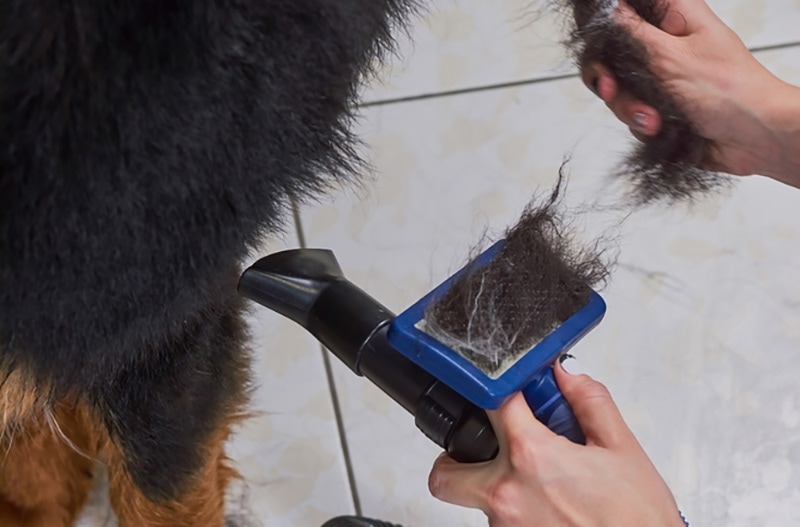
8. Grooming the Face
The fur on a Bernese Mountain Dg’s face is more dense than the fur on the rest of its body. Faces get dirty often as dogs are always nose-to-the-ground, and shed fur can’t escape as well as it can in less-dense areas. A small slicker brush is great for this; it’s good at pulling old hair from the coat and giving it a sheen. Be careful of your Bernese’s eyes, nose, and lips!
9. Look at Their Ears
An ear clean and check is essential to grooming a Bernese Mountain Dog. They have ears that flop over, so while they’re cute, they can trap dirt and are more prone to infections than straight-eared dogs. To check your Bernese’s ears, gently hold one up at a time and check for any redness, inflammation, or discharge. Dirt often looks brown, and a build-up of brown wax can signify a problem. The outer ears can be cleaned with an ear cleaner and gently wiped off.
10. Check Their Teeth
Teeth brushing should already be a part of your Bernese’s daily routine. Gently raise its lips and look at its teeth as part of their weekly groom, being careful not to hurt them. Look for any redness or swelling of the gums and any tartar build-up. These can be early indicators of gum disease and tooth decay, which a vet should assess as soon as possible to prevent the problem from worsening.
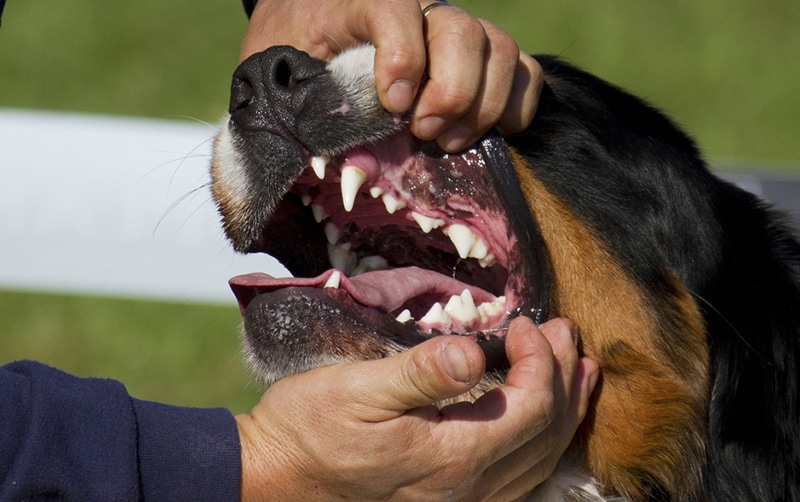
11. Nail Clipping
Nails should be clipped regularly to keep them in good shape; once a week as part of the groom is enough. If needed, the claws can be clipped using a guillotine clipper or nail scissors and filed into shape. If your Bernese Mountain Dog regularly walks on concrete, it will wear its nails down. If you need to clip them, be aware of the quick; the quick is the pink part at the base of the nail that provides blood and nutrients to the rest of it.
The quick is easily visible on white nails but more difficult to see on dark nails. Clip in small increments at an angle, and stop if you notice a small red or pale dot forming in the middle of the dog’s nail; this indicates that the quick is close.
12. Brush Your Bernese More During Shedding Season
Bernese Mountain Dogs shed their coats heavily twice a year. This happens all year round but is much more noticeable during shedding season. So be prepared for a lot of hair! When this g happens, more regular grooming is needed to keep your Bernese comfortable and reduce the cleanup for you. A good brush will collect all the shed hair, and tools like rakes and curry brushes can strip the hair out of the coat with minimal fuss.
13. If Stuck, Consider Hiring a Groomer
Bernese Mountain Dogs are enormous, and if they’re stubborn, it can make grooming challenging. Even a perfectly behaved dog won’t like having tangles pulled; any pain experienced during the process can make them adverse to grooming in the future. If your Bernese has tangles or mats that you’re not confident dealing with, make an appointment with a professional groomer. They have specialist training and tools to deal with all kinds of coats and problems, and your dog will thank you.
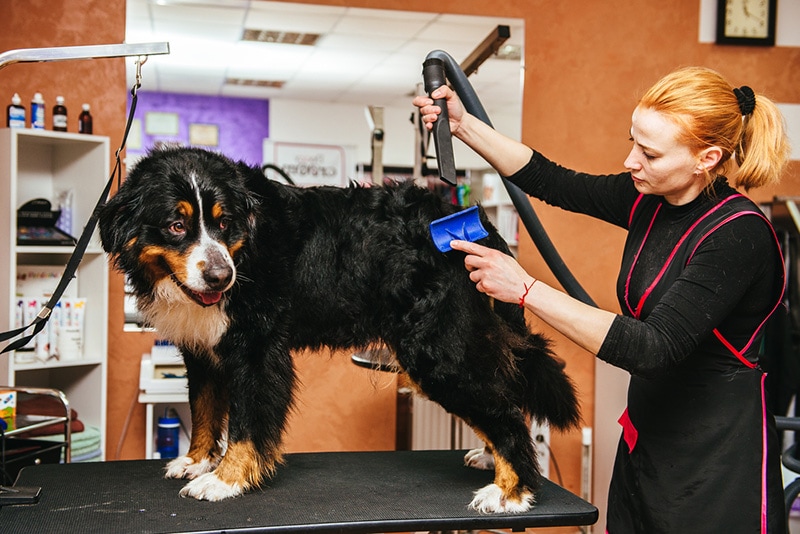
14. Keep It Positive
Above all, never shout at your Bernese Mountain Dog while grooming, use physical punishment, or yank on tangles. This will scare your dog, cause pain, and make it very difficult to groom it in the future. Using negative behavior when grooming won’t change how they act if they’re scared or uncomfortable; gentleness, patience, and praise go a long way when encouraging a nervous dog to relax into a grooming session. If you make the groom positive, it’ll make grooming easier in the future.
15. Keep the Environment Calm
This tip is for both the Bernese Mountain Dog and its groomer. Stress management can make a big difference to the overall grooming experience. Keep noise to a minimum and limit the number of people present for the groom. The groomer (you) and one helper are enough.
To Bathe or Not to Bathe?
Regular bathing of your Bernese Mountain Dog is recommended in most circumstances. While you should only bathe them if needed, some Bernese love to get dirty while playing outside. Bathing a dog of this size shouldn’t be undertaken lightly; you’ll need two people to do a good job.
Because the Bernese Mountain Dog is long-haired, a moisturizing shampoo and conditioner can keep the coat tangle-free and lustrous while conditioning the skin. A non-slip mat in the bath is essential, as it’s easy for dogs to slip on the tub floor. Consider getting an extra rug for the bathroom floor, as it’s likely to look like a hairy swimming pool once the bath is done!
Most importantly, ensure your Bernese Mountain Dog is completely dry once the bath is finished. Absorbent towels are needed, as the coat is thick and can trap moisture, making them cold. If you want to bathe your Bernese Mountain Dog, groom them first! Wetting tangled fur will tangle it further, making it harder to separate.
- Related Read: 10 Best Harnesses for Bernese Mountain Dogs
Final Thoughts
Bernese Mountain Dogs have lovely coats that can be challenging to groom if not prepared. They are long-haired dogs that shed all year, with two “shedding seasons” requiring more intense grooming. The Bernese can be groomed at home, and the tips we’ve laid out above can help guide you through it. We hope you’ve found our tips and tricks informative; you can take them with you when you begin your grooming session to ensure you groom your Bernese Mountain Dog thoroughly, from top to tail.
Featured Image Credit: DenisProduction.com, Shutterstock





